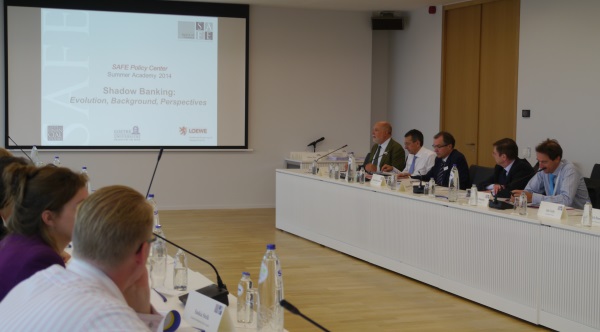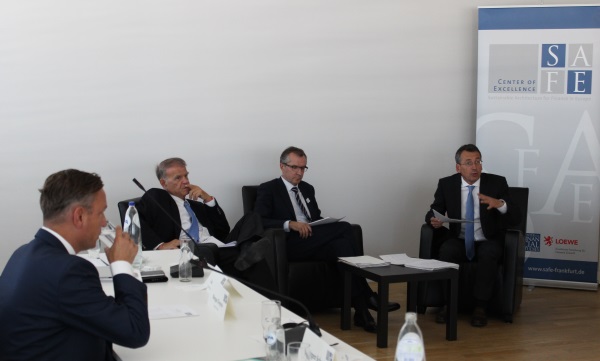
On 3 September, the second SAFE Summer Academy, entitled “Shadow Banking: Evolution, Background, Perspectives”, was held in Brussels, at the representation of the State of Hessen. Jan Krahnen, Program Director of the SAFE Policy Center and Günter Beck, Academic Director of the Summer Academy, welcomed more than 35 participants coming from nine different European member states and representing many of the institutions involved in the legislation and implementation of financial markets regulation: the European Commission, the European Parliament, the Council of the EU, national parliaments, European ministries of finance, the European Central Bank and national central banks.
On an annual basis, SAFE organizes a Summer Academy designed as a one-day training seminar for European policymakers dealing with financial market regulation. This year’s program offered an analytical, fact- and evidence-based assessment of the size and economic role of the shadow banking system. The question at the heart of all presentations was that of the impact on financial stability arising from shadow banking activities. The analyses offered by the prominent presenters led to lively discussions on whether to regulate shadow-banking activities, such as money-market funds or derivatives markets.
Thomas Wieser, President of the Economic and Financial Committee of the European Union, opened the Summer Academy with a keynote-address. He argued that since Europe is – comparatively speaking – overbanked, there is a need for de-leveraging in the banking sector and therefore also for other sources of credit. He stressed that any potential regulation of shadow banking activities should be coordinated internationally, as a level-playing field (also vis-à-vis the United States) is of central importance.
The following first topical session was devoted to “Defining and measuring the shadow banking system in the euro area (also in comparison to the U.S.)”. Bernhard Winkler (ECB) and Steffen Kern (ESMA) presented definitions and measures for shadow banking, to substantiate a better understanding of the role of shadow banking in financial intermediation and the extent of shadow banking in the euro area and globally.
In the second session, Günter Beck (SAFE and University of Siegen) presented joint research with Hans-Helmut Kotz (SAFE and Harvard University) which aims at computing the trade-off incurred by increasing financial regulation, thereby enhancing financial stability, but at the cost of less financial intermediation.
Mammohan Singh (IMF) led the first afternoon session on “The economics and policy of shadow banking regulation.” Amongst others, he emphasized the high pro-cyclicality of shadow banking with potentially adverse real-sector consequences and pointed out the likely important interactions with monetary policy. He also gave an overview and assessment of regulatory proposals for the shadow-banking system.
The second afternoon session focused on two selected shadow banking entities/processes: (i) money market funds and (ii) securitization. Morgan Després (Banque de France) presented an analysis of potential risks to financial stability associated with money market funds and the regulatory responses currently under way in the US and the EU. Jürgen Schaaf (ECB) gave a market overview of securitization and discussed the benefits of the creation of a more robust and sustainable securitizations market in Europe.
The day closed with a panel discussion on: “What kind of regulation for the (European) shadow banking system?” Jan Pieter Krahnen (SAFE and Goethe University) discussed with Pentti Hakkarainen (Deputy Governor, Bank of Finland) and Jean-Pierre Landau (Sciences Po) the underlying question of the day: Is there a systemic risk component in the risks associated with shadow banking activities, thereby justifying regulation in these markets?


